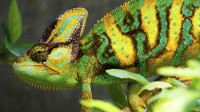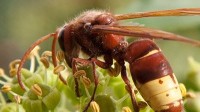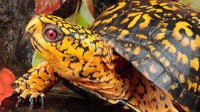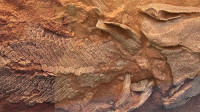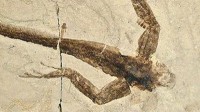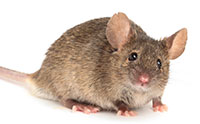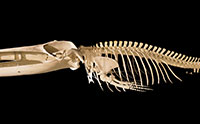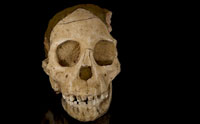A highly unusual spider testifies to biblical creation. …read more Read more here: creation.com
We hope you enjoy this sneak preview from the now-released December issue of Journal of Creation. Subscribers will be delighted by the powerful, stimulating content. …read more Read more here: creation.com
Sunlight can change in a heartbeat. One second, a leaf could be under intense sun and may receive more light than it needs to build sugar molecules through a process called photosynthesis. But a few seconds later, a cloud may wander overhead and block the sun, starving the plant’s photosynthetic machinery. A team of plant biologists recently discovered new mechanisms that help plants cope with these fast-changing light conditions. More… …read more Read more here: icr.org
Creationists are often slammed for saying that e.g. abiogenesis (chemicals to first life) is all part of ‘evolution’. But leading evolutionists affirm the creationist claim-and more. …read more Read more here: creation.com
Evolutionists declare stickier toes reveal the path up the evolutionary tree. …read more Read more here: AIG Daily
Refuting creationist Randy Guliuzza’s criticisms of natural selection, which is actually an important part of the creation model. …read more Read more here: creation.com
Recently the abdomen of a certain hornet was discovered to have intricate structures that look like space-age solar panels. …read more Read more here: AIG Daily
Scientists who try to make a case for the ‘evolution’ of the hand actually highlight its perfect design. …read more Read more here: creation.com
Eastern box turtles can literally be “frozen alive” and emerge unharmed. …read more Read more here: AIG Daily
The design in the complex movements of plants is obvious. …read more Read more here: creation.com
“A man scattered seed on the ground. Night and day, whether he sleeps or gets up, the seed sprouts and grows, though he does not know how.” Though he does not know how. Those words of Jesus (Mark 4:26b–27) are still true today. As a trained PhD plant scientist myself, I can vouch that, despite the many thousands of man-hours of ongoing research devoted to studying seeds, seed germination and seedling growth, we still don’t really know in detail how it is possible—certainly no-one has been able to build anything that can do what a seed does! The scientific journals [More]
Evolutionary researchers contend mammalian ancestors evolved night vision before the age of dinosaurs. …read more Read more here: AIG Daily
Ancient microfossils have supposedly solved the evolutionary enigma of the Cambrian Explosion. …read more Read more here: AIG Daily
Baleen whales feed very energetically, requiring precise coordination to avoid breaking their jaws …read more Read more here: creation.com
Scientists are learning more and more about the marvelous abilities of animals, which go far beyond physical design. …read more Read more here: AIG Daily
What makes sleep so mentally refreshing? University of Rochester neuroscientist Jeff Iliff addressed the crowd gathered at a September 2014 TEDMED event and explained his amazing new discoveries. The words he used perfectly match what one would expect while describing the works of an ingenious designer. More… …read more Read more here: icr.org
Soft skin tissue, known as keratin, has been found in fossilized lizard skin from the USA’s Green River Formation. …read more Read more here: AIG Daily
Germophobes beware: a new study suggests that all adults have face mites. But did they follow us through evolutionary history? …read more Read more here: AIG Daily
Giant clams living in the Pacific Ocean’s shallow-water tropics display brilliant, iridescent colors. Why do they display such radiance? Researchers uncovered five high-tech specifications that show how these giant clams use specialized iridescent cells to farm colonies of algae. More… …read more Read more here: icr.org
Great pitchers make it look so easy, and “practice makes perfect,” but it helps that the brain power necessary for control, neurological connections, and muscular arrangements for the human arm are exceedingly better than any system that exists on the planet. Is throwing a ball really that complex? More… …read more Read more here: icr.org
Scientists purposefully made mice sick to test how the creatures’ intestines—and the microbes they harbor—would react. They discovered details behind a remarkable relationship that, when working well, keeps both parties healthy. More… …read more Read more here: icr.org
Human faces evolved to vary as much as Mr. and Mrs. Potato Head, evolutionists say. …read more Read more here: AIG Daily
Tiny technology—an environmentally matched biological cloaking device—hides shrimp in plain sight. …read more Read more here: AIG Daily
Few animal traits are trotted out as illustrations of evolution as often as the whale’s supposed vestigial hip bones. Recent research has uncovered new details about the critical function of these whale hips—details that undermine this key evolutionary argument and confirm divine design. More… …read more Read more here: icr.org
Katydids solve acoustic impedance matching problem in tiny ears on their legs. This could inspire designs of tiny microphones. …read more Read more here: creation.com
A fossil group of alleged evolutionary human ancestors called australopithecines—all quite ape-like in their features—have traditionally been uncooperative as transitional forms. Now the famous Taung child, a supposed example of early transitional skull features, has been debunked. More… …read more Read more here: icr.org
‘A dog is man’s best friend’? But there are good reasons to beware the dingo! …read more Read more here: creation.com


























